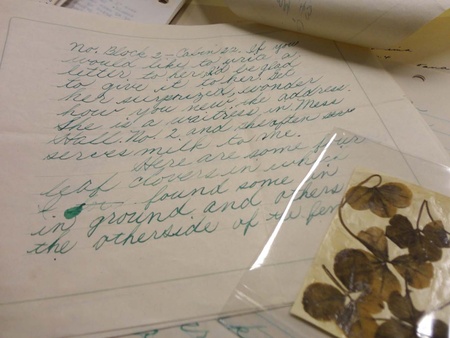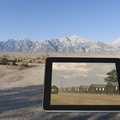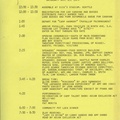Read Chapter 2 (3) >>
4. Connecting the "Meeting Place" with the Outside World
Even if you live surrounded by barbed wire, if you can feel that there is a world outside, you can weave hope for the future. Breed continued to send books and letters, the second generation young people aspired to work in the school and library in the assembly center, the teacher sisters "kept delivering salami and the school," the high school student who had been in charge of cleaning the newspaper office was made into a new correspondent, the people who visited the "assembly center," and the librarians who brought books and encouragement to the unfamiliar librarians in the camps - all of these people may have wanted to be close to the children in their own way, to tell them that there is a world outside, and that there are people who believe in them and are waiting for them.
letter
The other day, I was reading letters that children had sent from the internment camps in the Special Collections section in the basement of the Allen Library at the University of Washington, when I came across Tokunari's letter, written in beautiful cursive with green ink, in the file of Mr. Evenson1 at Washington Middle School.
After arriving at the temporary camp on May 8, he wrote three letters in ten days, on the 10th, 13th, and 18th. His letters show that he is calm, and even shows concern for his friends he left behind in Seattle, telling a classmate who was worried about the situation in the camp, "I think the situation here will improve soon, so don't worry too much." In the letter dated the 13th, he answers a question from the class, so try to understand the question from everyone's answer. When he picked up the letter dated the 18th, something fell on his desk. It was a four-leaf clover that had turned brown after 70 years. What was Tokunari thinking as he searched alone around the barbed wire for a four-leaf clover for his beloved teacher and friends at school?

(Photo by author, University of Washington Special Collections)
May 10
Dear Mr. Evenson and your class,
After two days of packing up and working on our new home in Puyallup, I said a quick "hello" to everyone. First, let me tell you about our room. Seven of us shared one room. The wallboards were full of knots and cracks, and the cold got in strangely, so I couldn't sleep at all last night. I didn't have much to eat, so I ate sandwiches and crackers when I got back to my room. The bed was borrowed from the Army, and the mattress was a cloth bag stuffed with straw.
This is a good place to stop, so I'll stop here. Until next time, see you later. Everyone, write me a letter.
Tokunari, an evictee from Seattle
May 13
Dear Mr. Evenson and your class,
I think everyone else feels the same way, but I'm really disappointed that Haruo isn't in the same camp as me. I think he's probably in Camp D.
Thank you to you for being so kind as to send me a beautiful four-leaf clover. But even more so to everyone who wrote me such lovely letters. I'm tired today, so I don't have much to do. I'll try to answer as many of your questions as I can.
1. To Edward: There is no school.
2. To Davey and Woofie: I hope Woofie gets better soon. And please send me a picture of the two of you.
3. To Solomon: Don't worry too much.
4. Dear Herbert, I'm sorry that Haruo isn't in camp with me, so I'll send your "Hello!" back to him as unrecipient.
5. To Ralph: I just put a flat board on top. Does that answer your question?
6. Dear Richard: I think things will get better here soon, so don't worry too much.
7. Dear Albert: I hope to come home again.
8. Dear Katie: Stop doing naughty things before I get back. I've got the perfect spatula for a girl like you.
9. Dear Louise, I wonder if you were collecting stamps? I need to get some more before I get busy sorting and pasting them. Don't forget your old stamps.
10. To Shishir: I think you’ve improved your writing skills. Keep it up.
11. Dear Mary: I know you said candy is hard to come by, but I hope it's not too bad. We don't have any here.
12. To my best friend Walter: You wrote that you saw my mother at home. What was she doing in the picture? Please tell me in your next letter.
That's all. Until next time, see you.
Your student, Tokunari
May 18
Dear Mr. Evenson and your class,
You asked if there is anyone here from your class. Yes, but there is only one, Yuriko. She happens to live across the street from my house. Her address is Area C-Block 2-Cabin 22. If you write her a letter, I will give it to her. And surprise her. She will wonder how we (the teachers and everyone) knew her address. She works as a waitress in the second cafeteria and sometimes gives us milk.
This is a four-leaf clover that I found in the camp and around the barbed wire. Please keep it as a keepsake of all your friends here.
Tokunari, forever friends
P.S. Thank you for the gum and candy you sent me. I also collected a lot of stamps.
Notes:
1. Letters by Tokunari Kawada, May 10, May 13, and May 18, 1942. Ella C. Evanson Scrapbook. University of Washington Libraries Special Collections.
Ms. Evenson was a homeroom teacher and school librarian at Washington Middle School. She was the child of immigrant parents who came to America from Norway in the 1870s and farmed the wilds of North Dakota. I have not used the last names of the children here, only their first names.
2. Once, a teacher used a flat wooden spatula with a handle, about 40 cm long, to punish a student. Tokunari was joking, of course, but I wonder what Katie was doing.
*Reprinted from the 134th issue (July 2013) of “Children and Books,” a quarterly magazine published by the Children’s Library Association.
© 2013 Yuri Brockett






